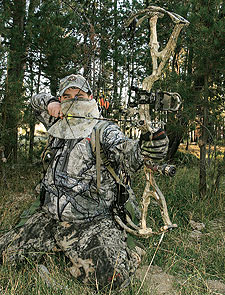October 28, 2010
By Randy Ulmer
By Randy Ulmer
 For years, experienced archers have advocated longer bows because of their stability. They are now re-thinking their position, because new technology has made short axle-to-axle bows very forgiving. |
Let's talk stability this month. I used to dislike short axle-to-axle length bows, but as technology has improved, these bows have become increasingly more forgiving and accurate. I must admit I'm hunting with two short bows now -- a 32-inch Hoyt Katera and a 35-inch Hoyt Alphamax -- and they are remarkably forgiving. For all their improvements, however, no short bow will ever be as stable as a longer bow. With that said, all the advantages of today's shorter bows far outweigh a little more stability.
Here is a basic analogy that will clear up many misconceptions about short bow stability. Suppose you have to walk a tightrope over a busy street in New York City. You are going to have to walk 200 feet above the busy traffic. You are offered your choice of two aids: a 40-foot pole that weighs 20 pounds or a four-foot pole that weighs 17 pounds.
Advertisement
Of course you choose the longer pole, because it makes you more stable. Much more effort is required to rotate the longer pole than the shorter one, even though they weigh nearly the same.
Because of the added rotational inertia, the longer pole better helps maintain balance because it resists movement better. In an exaggerated way, that is exactly why longer bows are more unwavering throughout the shot than shorter bows. Short bows can never be as stable as long bows -- end of story. However, they can be stable enough if shot correctly.
Advertisement
Accuracy: It's In The Grip
If you've ever shot a slingshot, you know your pressure point on the grip is critical to consistency. Your hand position has to be perfect every time. Being off by even a small amount will throw your stone well wide of the mark.
The same is true of short bows. Because they don't have extended lever arms for stability, your grip becomes more critical. Your pressure point, the primary point of contact between the bow and your hand, has to be identical on every shot.
Every time you place your hand on the grip, place it in exactly the same spot. You may have to physically look at your hand at first, but soon you will begin to feel the correct position and get into the shot much more quickly. Until that happens, take every measure to be sure your grip is exactly the same each time you begin the draw.
Just as importantly, once you set your hand on the grip, don't change the position until after the arrow is in the target. I see some bowhunters change their grip position as they draw the bow back. That will never produce the consistency you need to shoot a short bow as well as a longer bow. Set the hand carefully and correctly before drawing.
To counteract any loss in stability when shooting a short bow, you must also be very conscious of keeping your bow hand perfectly relaxed throughout the shot. You must absolutely avoid snapping your hand closed at the moment of release.
Secondary Anchor Point
Many bowhunters touch their nose to the string at full draw to form a secondary anchor point. When you try to do this with a super short bow, the acute string angle will force you either to draw the bow too far back or to tip your head forward unnaturally to meet the string. It is very likely when shooting such a bow that you will have to make some changes from your normal setup to get the string to touch your nose. I tend to use a shorter D-loop and a release such as the Carter RX with a short trigger-to-hook distance.
Measure Your Options
Conventional archery wisdom suggests a bow with a high brace height is more forgiving than one with a low brace height. Since short bows are already somewhat less forgiving than long bows, it makes sense to choose one with at least a moderate brace height. The better your shooting form, the lower the brace height you can get away with.
No one says you have to shoot a short bow. There are still a number of bows on the market exceeding 36 inches. If you want maximum stability, look at one of these.
If you decide the portability of a short bow, along with added speed and reduced weight, is more important than maximum stability, you must be more concerned with the fine points of shooting form. The bow's length won't bail you out if you twitch. Focus on improving these aspects of form and you will shoot your short bow more accurately.
